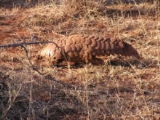
Temminck's Pangolin
Encyclopedia
The Ground Pangolin also known as Temminck's Pangolin or the Cape Pangolin, is one of four species of pangolin
which can be found in Africa
and the only one in southern and eastern Africa. Although it is present over quite a large area, it is rare throughout it and notoriously difficult to spot. Its scarcity is partly because it is hunted by humans for its scales, which are used in love charms, and partly because it is often burnt in bush fires. It was once designated an endangered species
by the United States Fish and Wildlife Service
,.
With the exception of the underside, it is covered in extremely hard scales. When threatened, it usually will roll up into a ball to protect the vulnerable belly. The scales on the tail can also be used as blades to slash at attackers.
The Ground Pangolin can grow to a length of about 1 metre, with the tail typically between 30 and 50 cm. It has a disproportionately small head, powerful hindlegs, and small forelegs. Walking is done almost entirely on the backlegs with the heavy dragging tail acting as a counterweight.
Like other pangolin species, it is largely nocturnal, although it is also entirely terrestrial and usually found in savanna
or open woodland
, generally feeding on termites or ants. It is well adapted to this, with a very long (up to 50 cm) sticky tongue which is stored inside a pocket in the mouth until needed. Although it is capable of digging its own burrow, it prefers to occupy disused holes dug by a Warthog
or an Aardvark
or to lie in dense vegetation, making it even more difficult to observe.
This animal was named for the Dutch zoologist Coenraad Jacob Temminck
.
Pangolin
A pangolin , also scaly anteater or Trenggiling, is a mammal of the order Pholidota. There is only one extant family and one genus of pangolins, comprising eight species. There are also a number of extinct taxa. Pangolins have large keratin scales covering their skin and are the only mammals with...
which can be found in Africa
Africa
Africa is the world's second largest and second most populous continent, after Asia. At about 30.2 million km² including adjacent islands, it covers 6% of the Earth's total surface area and 20.4% of the total land area...
and the only one in southern and eastern Africa. Although it is present over quite a large area, it is rare throughout it and notoriously difficult to spot. Its scarcity is partly because it is hunted by humans for its scales, which are used in love charms, and partly because it is often burnt in bush fires. It was once designated an endangered species
Endangered species
An endangered species is a population of organisms which is at risk of becoming extinct because it is either few in numbers, or threatened by changing environmental or predation parameters...
by the United States Fish and Wildlife Service
United States Fish and Wildlife Service
The United States Fish and Wildlife Service is a federal government agency within the United States Department of the Interior dedicated to the management of fish, wildlife, and natural habitats...
,.
With the exception of the underside, it is covered in extremely hard scales. When threatened, it usually will roll up into a ball to protect the vulnerable belly. The scales on the tail can also be used as blades to slash at attackers.
The Ground Pangolin can grow to a length of about 1 metre, with the tail typically between 30 and 50 cm. It has a disproportionately small head, powerful hindlegs, and small forelegs. Walking is done almost entirely on the backlegs with the heavy dragging tail acting as a counterweight.
Like other pangolin species, it is largely nocturnal, although it is also entirely terrestrial and usually found in savanna
Savanna
A savanna, or savannah, is a grassland ecosystem characterized by the trees being sufficiently small or widely spaced so that the canopy does not close. The open canopy allows sufficient light to reach the ground to support an unbroken herbaceous layer consisting primarily of C4 grasses.Some...
or open woodland
Woodland
Ecologically, a woodland is a low-density forest forming open habitats with plenty of sunlight and limited shade. Woodlands may support an understory of shrubs and herbaceous plants including grasses. Woodland may form a transition to shrubland under drier conditions or during early stages of...
, generally feeding on termites or ants. It is well adapted to this, with a very long (up to 50 cm) sticky tongue which is stored inside a pocket in the mouth until needed. Although it is capable of digging its own burrow, it prefers to occupy disused holes dug by a Warthog
Warthog
The Warthog or Common Warthog is a wild member of the pig family that lives in grassland, savanna, and woodland in Sub-Saharan Africa. In the past it was commonly treated as a subspecies of P...
or an Aardvark
Aardvark
The aardvark is a medium-sized, burrowing, nocturnal mammal native to Africa...
or to lie in dense vegetation, making it even more difficult to observe.
This animal was named for the Dutch zoologist Coenraad Jacob Temminck
Coenraad Jacob Temminck
Coenraad Jacob Temminck was a Dutch aristocrat and zoologist.Temminck was the first director of the National Natural History Museum at Leiden from 1820 until his death. His Manuel d'ornithologie, ou Tableau systematique des oiseaux qui se trouvent en Europe was the standard work on European birds...
.

